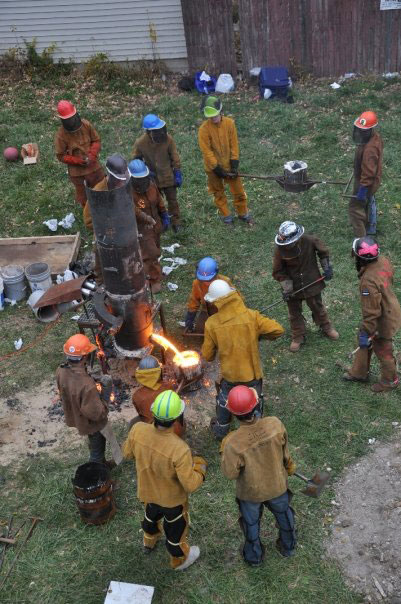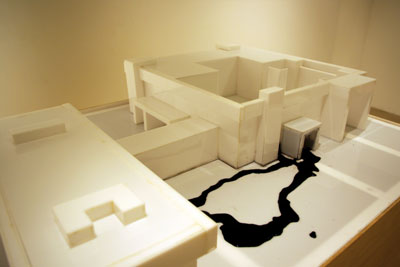An outsider’s introduction to the life of Ceramics student Luke Armitstead
By Britany Robinson

Students in the Ceramics Department may seem to be elbow deep in a big-kid’s version of Play-Doh, but the intense concentration on their faces as they hunch over their creations looks far from playful. This is my first time in SAIC’s Columbus Drive building, which houses the studio spaces for many of the Fine Arts departments — including Sculpture and Ceramics.
As an SAIC New Arts Journalism graduate student, I hesitantly admit that I have never even seen this part of the school, nestled away from SAIC’s main drag between the museum and the lakefront. I walked over with Luke Armitstead, a junior Ceramics student, who is here to introduce me to a world I know nothing about.
This disconnect between Luke and me seems typical of the often disjointed community of SAIC. We are all so focused on our own work — often overwhelmed by the pairing of our classes with the overachiever attitudes that got us here in the first place — that we tend to miss out on the plethora of art made by the students around us. I was elated at the opportunity to speak with someone whose experience is so vastly different from my own.
The Ceramics Department is dusty, noisy, and full of intriguing works-in-progress. Luke is on break from a painting class and has some green smudges on his face and hands. I feel slightly envious of the hands-on activities that make up his education here.
Although his focus is on ceramics, Luke has taken woodworking, sculpture and painting classes as well — all of which he feels add dimension and marketability to his skill set. One of the reasons Luke chose SAIC was because it allows students to move from department to department in order to develop a range of artistic skills.
While showing me around the studio, Luke directs me to a piece he is working on. A giant blue hand is all that is available for me to see; the rest of the body to which it will eventually be attached is left to my imagination. The hand has angular edges and a very geometric feel, but, from a distance, it looks organic and lifelike — lifelike, of course, if there were such things as giant blue monsters with hands the size of one’s dormitory mini-fridge.
I ask him about the inspiration behind the hand (which will eventually be part of the main piece in his BFA show). “The idea of my ceramic body was really an impulse to make something difficult to acquire,” he explains.
So far he has completed the torso, the hand, two legs and two feet, and is undecided as to how it will all come together in its completed state. The shelves where the hand is stored are full of other partially completed ceramic pieces, and I wonder where all of these materials come from.
Luke tells me that the strongest aspect of the SAIC Ceramics department is the free materials: “You can make whatever you want in ceramics [with free clay and glaze]. A lot of people come down here from other departments. The material is very malleable. The glaze can be very much like painting.”
Unfortunately, the access to materials only lasts until graduation. After that, ceramics becomes an expensive art to practice. Luke seems slightly daunted by the cost of running a kiln for any pieces he might want to create after graduation — that is where his skills in other mediums will come in handy.
“[Ceramics] is what I love. … Eventually, in the future, I’m going to find myself back in ceramics, but I think after school — when I don’t have as much money, and the school to help me out — I’ll probably be dealing a lot more with wood and found objects,” Luke says.
As we chat on the window seats of a hallway in the Columbus Drive building, various faculty members and students walk by, all of whom wave ”hello” to Luke. An obvious network exists in the department, and his relaxed demeanor with both students and teachers tells me that this is a supportive community.
After an enthusiastic greeting to one of the teachers we pass, Luke tells me about the “magical” inspiration this particular professor has on students: “Professor Xavier Toubes tells me to just keep going, keep working hard, keep experimenting, and then says we’ll talk. I keep working, keep experimenting, and keep talking with him in depth. It’s genius; you have a very close, respectful relationship with your teachers.”
Digging your hands into a wad of clay sure looks like fun — the students sitting at work benches in the Ceramics Department appear to be enjoying their projects. However, the program is actually very demanding. Luke spends at least forty hours a week in the studio.
When I ask him what sort of advice he could offer to incoming students who are interested in ceramics, he vehemently says to “work as hard as you can. Tackle everything there is to know
about ceramics.”
Pleased with an afternoon well spent, I took Luke’s passion for his work back to the MacClean building, returning to my own artistic practice — writing.







